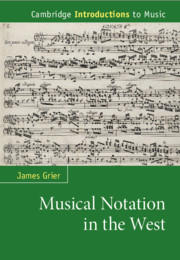Book contents
- Musical Notation in the West
- Musical Notation in the West
- Copyright page
- Dedication
- Contents
- Figures
- Tables
- Musical Examples
- Preface
- Chapter 1 Introduction: Musical Notation as a Symbolic Language
- Chapter 2 Plainsong and the Origins of Musical Notation in the West
- Interlude 1: The Problem with Pitch
- Chapter 3 Polyphony and Rhythmic Notation
- Interlude 2: Rhythm and Metre
- Chapter 4 The Transition to the Modern Era: Instrumental Music and Performing Indications
- Interlude 3: The Score
- Chapter 5 Notational Nuance in the Twentieth Century and the Motives for Notational Innovation
- Coda: The Meaning of Musical Literacy
- Bibliography
- Index
- Cambridge Introductions to Music
Chapter 3 - Polyphony and Rhythmic Notation
Published online by Cambridge University Press: 28 January 2021
- Musical Notation in the West
- Musical Notation in the West
- Copyright page
- Dedication
- Contents
- Figures
- Tables
- Musical Examples
- Preface
- Chapter 1 Introduction: Musical Notation as a Symbolic Language
- Chapter 2 Plainsong and the Origins of Musical Notation in the West
- Interlude 1: The Problem with Pitch
- Chapter 3 Polyphony and Rhythmic Notation
- Interlude 2: Rhythm and Metre
- Chapter 4 The Transition to the Modern Era: Instrumental Music and Performing Indications
- Interlude 3: The Score
- Chapter 5 Notational Nuance in the Twentieth Century and the Motives for Notational Innovation
- Coda: The Meaning of Musical Literacy
- Bibliography
- Index
- Cambridge Introductions to Music
Summary
Beginning around A.D. 1000, musicians cultivated increasingly complex styles of polyphony. The earliest practical polyphony, from Winchester, Aquitaine and Paris, simply employed the prevailing style of plainsong notation. By the middle of the twelfth century, that notation accurately specified the pitch content of a melody, as I discuss in Chapter 2 and Interlude 1, and so the pitch content of the simultaneously sounding voices became secure. Rhythmic coordination in the Winchester polyphony of the eleventh century caused no problems because it proceeds in strict note-against-note style, and so each note in the organal voice corresponds to a single note in the liturgical chant. Aquitanian polyphony of the next century, however, often sets more notes in the upper voice than in the lower, and so debates ensue as to how to orient the two voices.
- Type
- Chapter
- Information
- Musical Notation in the West , pp. 61 - 134Publisher: Cambridge University PressPrint publication year: 2021

